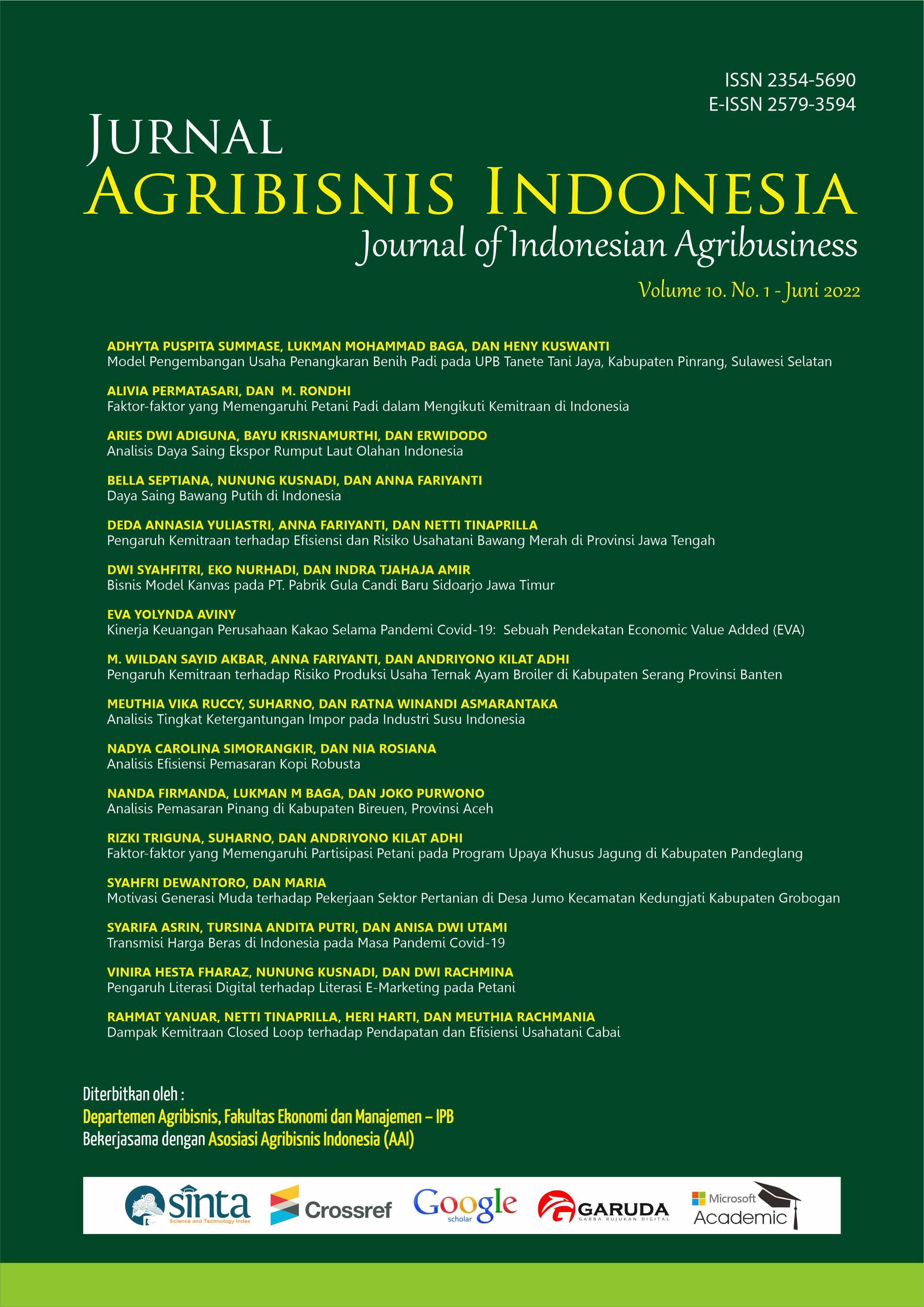Pengaruh Kemitraan Terhadap Efisiensi dan Risiko Usahatani Bawang Merah di Provinsi Jawa Tengah
Main Article Content
Abstract
Productivity of shallot in central Java as an area production center has a declining trend from 2013-to 2018. One way to increase productivity is through technical efficiency. However, to increase productivity, the probability of production risk will also be higher. Contract farming is one way to increase productivity and overcome production risks in shallot farming. The objectives of this study were to analyze the effect of contract farming on technical efficiency and perception of risks production between contract and non-contract farmers. Secondary data was used in this study. The research sample consisted of 1.508 (10 contract farmers and 1.498 non-contract farmers) shallot farmers in Central Java. The data were analyzed using the stochastic frontier method to see technical efficiency, and the Likert scale to see farmers' perceptions of production risk. The analysis shows that contract farming affected decreasing efficiency. Meanwhile, there is no difference between both farmers in perceptions of the risk of pest and disease attacks. Meanwhile, contract farmers’ perception of the risk of climate change was greater in decreasing production than non-contract farmers. Management efforts by both contract and non-contract farmers to overcome pests and plant diseases are no different. They both prefer chemical methods to overcome pest and disease plant attacks.
Downloads
Article Details

This work is licensed under a Creative Commons Attribution 4.0 International License.
Jurnal Agribisnis Indonesia (JAI) is an Open Access Journal. The authors who publish the manuscript in this journal agree to the following terms:
Creative Commons License
JAI is licensed under a Creative Commons Attribution 4.0 International License. This permits anyone to copy, redistribute, remix, transmit, and adapt the work provided the original work and source are appropriately cited.
This means:
(1) Under the CC-BY license, authors retain ownership of the copyright for their article, but authors grant others permission to use the content of publications in Jurnal Agribisnis Indonesia in whole or in part provided that the original work is properly cited. Users (redistributors) of JAI are required to cite the original source, including the author's name, JAI as the initial source of publication, year of publication, volume number, issue, and Digital Object Identifier (DOI); (2) Authors grant JAI the right of first publication. Although authors remain the copyright owner.
References
[BI] Bank Indonesia. 2016. Laporan “Pilot Project Skema Pembiayaan Pertanian melalui Penerapan Konsep Pembiayaan Rantai Nilai (Value Chain Financing)”. Jakarta: Bank Indonesia Divisi Pengembangan dan Pengaturan UMKM.Bank Indonesia
[BPPP] Badan Penelitian dan Pengembangan Pertanian. 2017. Budidaya Bawang Merah. Tersedia pada : https://www.hortikultura.litbang.pertanian.go.id/%2FModul%2520PTT%2FBawang_Merah%2FBudidaya%2520bawang%2520merah.pdf&usg=AOvVaw0GVc3gY4CD9dWtD0eqqeUm [21 Januari 2019].
[BPS] Badan Pusat Statistik. 2019. Produksi Bawang Merah di Indonesia. https://www.bps.go.id/site/resultTab [4 November 2019].
Coelli TJ, Rao DSP, O’Donnell, CJ, dan Battese GE. 1998. An Introduction to Effeciency and Productivity Analysis. New York: Kluwer Academic Publishers.
Fanani, A., Anggraeni, L., & Syaukat, Y. (2015). Pengaruh kemitraan terhadap Risiko Usahatani Tembakau di Kabupaten Bojonegoro Provinsi Jawa Timur. Jurnal Manajemen & Agribisnis, 12(3), 194-203. https://doi.org/10.17358/jma.12.3.194
Heningsen, A., Mpeta, D. F., & Adem, A. S. (2015). The Effect of Contract Farming and Productivity of Smal-Scale Sunflower Farmers in Tanzania. International Conference of Agricultural Economist (ICAE), August 2015. Universita A Degli Studi Milano. hlm 1-24.
Miyata, S. (2009). Impact of Contract Farming on Income: Linking Small Farmer’s, Packers, and Supermarkets in China. World Development, 37(11), 1781-1790. https://doi.org/10.1016/j.worlddev.2008.08.025
Napitupulu, D., & Winarto, L. (2010). Pengaruh Pemberian Pupuk N dan K terhadap pertumbuhan dan Produksi Bawang Merah. J.Hort, 20(1), 27-35. https://dx.doi.org/10.21082/jhort.v20n1.2010.p%25p
Nurjati, E., Fahmi, I., & Jahroh, S. (2018). Analisis Efisiensi Produksi Bawang Merah di Kabupaten Pati dengan Produksi Frontier Stokastik Cobb-Douglas. Jurnal Agro Ekonomi, 36(1), 55-69. https://dx.doi.org/10.21082/jae.v36n1.2018.55-69
Putrasamedja, S., Setiawati, W., Lukman, L., & Hasyim, A. (2012). Penampilan Beberapa Klon Bawang Merah dan Hubungannya dengan Intensitas Serangan Organisme Pengganggu Tumbuhan. J.Hort, 22(4), 349-359. https://dx.doi.org/10.21082/jhort.v22n4.2012.p349-359
Rihi, M. S. R., Hartoyo, S., & Fariyanti, A. (2014). Pengaruh Kemitraan dengan PT Indofood Firtolay Makmur (PT IFM) terhadap Efisiensi Petani Kentang di Kecamatan Pangalengan Kabupaten Bandung Provinsi Jawa Barat. Jurnal Aplikasi Manajemen, 12(2), 175-187. https://doi.org/10.17358/JMA.12.3.194.
Saptana, Indraningsih, K. S., & Hastuti, E. L. (2004). Analisis kelembagaan Kemitran Usaha di Sentra–Sentra Produksi Sayuran (Suatu Kajian atas Kasus Kelembagaan Kemitraan Usaha di Bali, Sumatera Utara dan Jawa Barat). Jurnal Sosial Ekonomi Pertanian, 7(3), 1-25.
Sayaka, B., & Supriatna, B. (2010). Kemitraan Pemasaran Bawang Merah di Kabupaten Brebes Jawa Tengah: Kasus PT Indofood Sukses Makmur. Prosiding Seminar Nasional Peningkatan Daya Saing Agribisnis Berorientasi Kesejahteraan Petani. Bogor: Pusat Analis Sosial Ekonomi dan Kebijakan Pertanian. hlm. 187-201.
Suwandi, Sopha, G. A, & Yufdy, M. P. (2015). Efektivitas Pengelolaan Pupuk Organik, NPK, dan Pupuk Hayati terhadap Pertumbuhan dan Hasil Bawang Merah. J.Hort, 25(3), 208-221. https://dx.doi.org/10.21082/jhort.v25n3.2015.p208-221
Suwandi. 2014. Budidaya Bawang Merah di Luar Musim Teknologi Unggulan Mengantisipasi Dampak Perubahan Iklim. Jakarta (ID): IAARD Press.
Tinaprilla N. 2012. Efisiensi Usahatani Padi Antar Wilayah Sentra Produksi di Indonesia: Pendekatan Stochastic Metafrontier Production Function. [disertasi]. Bogor: Sekolah Program Pascasarjana, Institut Pertanian Bogor.
Tongchure, S., & Hoang, N. (2013). Cassava Smallholders Participation in Contract Farming in Nakhon Ratchasirma Province, Thailand. Journal of Social and Development Sciences, 4(7), 332-338. https://doi.org/10.22610/jsds.v4i7.769
Tripathi, R. S., Singh, R., & Singh, S. (2005). Contract Farming in Potato Production: An Alternative for Managing Risk and Uncertainty. Agricultural Economic Research Review, 18, 47-60. https://doi.org/10.22004/ag.econ.58460
Umamageswari, M., Sharif, M., & Dubey, L. R. (2013). An Economic Analysis of Papain Production under Contract Farming in Western Zone of Tamil Nadu. Agriculture Update, 8(1&2):183-187.
Waryanto, B., Chozin, M. A., Dadang, & Intan, E. 2014. Analisis Efisiensi Teknis, Efisiensi Ekonomis dan Daya Saing Pada Usahatani Bawang Merah di Kabupaten Nganjuk-Jawa Timur: Suatu Pendekatan Ekonometrik dan PAM. Informatika Pertanian, 23(2), 147-158. https://dx.doi.org/10.21082/ip.v23n2.2014.p147-158

